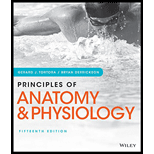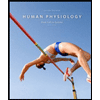
Principles of Anatomy and Physiology
15th Edition
ISBN: 9781119329398
Author: Gerard J Tortora, Bryan Derrickson
Publisher: John Wiley & Sons Inc
expand_more
expand_more
format_list_bulleted
Textbook Question
Chapter 16, Problem 2CTQ
Monique sticks her left hand into a hot tub heated to about $$ in order to decide if she wants to enter. Trace the pathway involved in transmitting the sensation of heat from her left hand to the somatosensory area in the cerebral cortex.
Expert Solution & Answer
Want to see the full answer?
Check out a sample textbook solution
Students have asked these similar questions
Monique sticks her left hand into a hot tub heated to about 43 C (110 F) in order to decide if she wants to enter. Trace the pathway involved in transmitting the sensation of heat from her left hand to the somatosensory area in the cerebral cortex.
A patient has had a stroke that damaged the trigeminal nerve but not the facial, glossopharyngeal, or vagus nerve.Would this individual still be able to taste the difference between hot peppers and French fries? Explain your answer
A 20-year-old woman is brought to the emergency department 30 minutes after being found unconscious in her dormitory room. Part of the physical examination involves observing for conjugate eye movements after carefully opening the patient's eyelids and turning the head to the right and then to the left. The presence of this reflex suggests that the neural pathway from which of the following receptors is intact?
A) Anterior semicircular canals
B) Horizontal semicircular canals
C) Posterior semicircular canals
D) Saccule
E) Utricle
Chapter 16 Solutions
Principles of Anatomy and Physiology
Ch. 16 - How is sensation different from perception?Ch. 16 - 2. What is a sensory modality?
Ch. 16 - What is a receptor potential?Ch. 16 - What is the difference between rapidly adapting...Ch. 16 - Prob. 5CPCh. 16 - Prob. 6CPCh. 16 - Which somatic sensory receptors mediate touch...Ch. 16 - How does fast pain differ from slow pain?Ch. 16 - Prob. 9CPCh. 16 - 10. What aspects of muscle function are monitored...
Ch. 16 - What are the functional differences between the...Ch. 16 - Prob. 12CPCh. 16 - 13. What type of sensory information is carried in...Ch. 16 - Prob. 14CPCh. 16 - 15. Which parts of the body have the largest...Ch. 16 - Prob. 16CPCh. 16 - 17. Explain the role of the cerebral cortex, basal...Ch. 16 - Describe how sleep and wakefulness are related to...Ch. 16 - What are the four stages of non-rapid eye movement...Ch. 16 - Define memory. What are the three kinds of memory?...Ch. 16 - What is long-term potentiation?Ch. 16 - What is language?Ch. 16 - Prob. 1CTQCh. 16 - 2. Monique sticks her left hand into a hot tub...Ch. 16 - 3. Marvin has had trouble sleeping. Last night his...
Additional Science Textbook Solutions
Find more solutions based on key concepts
Describe Mendels conclusions about how traits are passed from generation to generation.
Concepts of Genetics (11th Edition)
Police Captain Jeffers has suffered a myocardial infarction. a. Explain to his (nonmedically oriented) family w...
Human Physiology: An Integrated Approach (8th Edition)
To test your knowledge, discuss the following topics with a study partner or in writing ideally from memory. Th...
Human Anatomy
CAUTION How can evolutionary fitness be estimated? a. Document how long individuals survive. b. Count the numbe...
Biological Science (6th Edition)
Knowledge Booster
Learn more about
Need a deep-dive on the concept behind this application? Look no further. Learn more about this topic, biology and related others by exploring similar questions and additional content below.Similar questions
- The amygdala, septal area, and olfactory cortex provide input to which thalamic nuclei? a. Reticular nucleus b. Medial geniculate nucleus c. Ventral lateral nucleus d. Medial dorsal nucleusarrow_forwardTerry is diagnosed with a lesion that damaged the right ventral posterior medial nucleus of the thalamus. What symptoms would you expect Terry to show? Question 8 options: a) Loss of pain, temperature, and mechanosensation from left face b) Loss of mechanosensation from full face c) Loss of pain, temperature, and mechanosensation from left face and left body d) Loss of pain and temperature from left face and loss of mechanosensation from right face e) Loss of pain and temperature from left face and left bodyarrow_forwardB.L., age 17 has a compression fracture at C5 to C6, a result of diving from a bridge into a river and hitting a submerged rock. Fortunately, a companion who had first aid training as a lifeguard rescued her and tried to minimize any secondary damage. In the emergency department, B.L. could not move her limbs or sense touch and lacked reflexes in her limbs or sense touch and lacked reflexes in her limbs. Explain. Clarify a topic by giving a detailed account as to how and why it occurs, where it occurs, what it is or what is meant by the use of the term in a particular context. Always consider the HOW, WHAT, WHERE and WHY – even if question only asks ie: “Explain why and how etc” Explain why reflexes are absent in B.L. at this early stage. Explain what specific type of paralysis is present at this early stage? Include the manifestations.(Support with 10 possible outcomes) Explain why and how B.L.’s respiratory function may be impaired at any time.(Support with 10 possible…arrow_forward
- B.L., age 17 has a compression fracture at C5 to C6, a result of diving from a bridge into a river and hitting a submerged rock. Fortunately, a companion who had first aid training as a lifeguard rescued her and tried to minimize any secondary damage. In the emergency department, B.L. could not move her limbs or sense touch and lacked reflexes in her limbs or sense touch and lacked reflexes in her limbs. Explain. Clarify a topic by giving a detailed account as to how and why it occurs, where it occurs, what it is or what is meant by the use of the term in a particular context. Always consider the HOW, WHAT, WHERE and WHY – even if question only asks ie: “Explain why and how etc” Explain why caution is needed when handling a person with a possible spinal cord injury. (Support with 8 possible outcomes) 2. What is a compression fracture? Explain why and how it can affect neurologic function.(Support with 10 possible outcomes) Explain why reflexes are absent in B.L. at this early…arrow_forwardB.L., age 17 has a compression fracture at C5 to C6, a result of diving from a bridge into a river and hitting a submerged rock. Fortunately, a companion who had first aid training as a lifeguard rescued her and tried to minimize any secondary damage. In the emergency department, B.L. could not move her limbs or sense touch and lacked reflexes in her limbs or sense touch and lacked reflexes in her limbs. Explain. Clarify a topic by giving a detailed account as to how and why it occurs, where it occurs, what it is or what is meant by the use of the term in a particular context. Always consider the HOW, WHAT, WHERE and WHY – even if question only asks ie: “Explain why and how etc” Explain why caution is needed when handling a person with a possible spinal cord injury. (Support with 8 possible outcomes) 2. What is a compression fracture? Explain why and how it can affect neurologic function.(Support with 10 possible outcomes)arrow_forwardWhich body parts have the largest representation in the primary somatosensory area?arrow_forward
- ____________ is understanding what particular sensations mean.arrow_forwardChoose the correct one. The amygdala, septal area, and olfactory cortex provide input to which thalamic nuclei? a. Reticular nucleus b. Medial geniculate nucleus c. Ventral lateral nucleus d. Medial dorsal nucleusarrow_forwardWhy Pain differs significantly from the other somatosensory modalities?arrow_forward
- Which of the following structures does not receive direct input from retinal ganglion cells? a. Primary visual cortex b. The suprachiasmiatic nucleus (SCN) in the hypothalamus c. The superior colliculus in the tectum d. The lateral geniculate nucleus (LGN) in the thalamus The Glossopharyngeal nerve (cranial nerve IX) is a “mixed nerve,” meaning that it carries sensory and motor information. One of the functions of this nerve is carrying taste information from the caudal third of the tongue. The fibers that carry this information in the glossopharyngeal nerve are classified as which component type? a. Special efferent b. Special afferent c. General visceral efferent d. General somatic afferentarrow_forwardFollowing a stroke Dr. Z was unable to recognize the members of his family when shown their portrait. It was different when he was in their physical presence, because then if he heard them speak or saw them move in particular ways he could identify them. Where is the most likely site of brain damage? Question 3 options: A) Ventral pathway from V1 to the fusiform gyrus B) Ventral pathway from V1 to amygdala C) Dorsal pathway from V1 to motor cortex D) Primary visual (V1) cortexarrow_forwardWhich location on the body has the largest region of somatosensory cortex representing it, according to the sensory homunculus?arrow_forward
arrow_back_ios
SEE MORE QUESTIONS
arrow_forward_ios
Recommended textbooks for you
 Human Physiology: From Cells to Systems (MindTap ...BiologyISBN:9781285866932Author:Lauralee SherwoodPublisher:Cengage Learning
Human Physiology: From Cells to Systems (MindTap ...BiologyISBN:9781285866932Author:Lauralee SherwoodPublisher:Cengage Learning Human Biology (MindTap Course List)BiologyISBN:9781305112100Author:Cecie Starr, Beverly McMillanPublisher:Cengage Learning
Human Biology (MindTap Course List)BiologyISBN:9781305112100Author:Cecie Starr, Beverly McMillanPublisher:Cengage Learning

Human Physiology: From Cells to Systems (MindTap ...
Biology
ISBN:9781285866932
Author:Lauralee Sherwood
Publisher:Cengage Learning





Human Biology (MindTap Course List)
Biology
ISBN:9781305112100
Author:Cecie Starr, Beverly McMillan
Publisher:Cengage Learning
Nervous System - Get to know our nervous system a bit closer, how does it works? | Neurology; Author: FreeMedEducation;https://www.youtube.com/watch?v=6O-0CVAgaEM;License: Standard youtube license